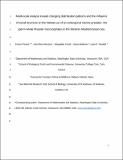Files in this item
Multi-scale analysis reveals changing distribution patterns and the influence of social structure on the habitat use of an endangered marine predator, the sperm whale Physeter macrocephalus in the Western Mediterranean Sea
Item metadata
| dc.contributor.author | Pirotta, Enrico | |
| dc.contributor.author | Brotons, José María | |
| dc.contributor.author | Cerdà, Margalida | |
| dc.contributor.author | Bakkers, Sanne | |
| dc.contributor.author | Rendell, Luke E. | |
| dc.date.accessioned | 2020-11-18T00:38:41Z | |
| dc.date.available | 2020-11-18T00:38:41Z | |
| dc.date.issued | 2019-11-18 | |
| dc.identifier | 263959118 | |
| dc.identifier | c2522c85-7850-4aea-8fcf-c5c3819096e5 | |
| dc.identifier | 85076523950 | |
| dc.identifier | 000508749000001 | |
| dc.identifier.citation | Pirotta , E , Brotons , J M , Cerdà , M , Bakkers , S & Rendell , L E 2019 , ' Multi-scale analysis reveals changing distribution patterns and the influence of social structure on the habitat use of an endangered marine predator, the sperm whale Physeter macrocephalus in the Western Mediterranean Sea ' , Deep Sea Research Part I: Oceanographic Research Papers , vol. In press . https://doi.org/10.1016/j.dsr.2019.103169 | en |
| dc.identifier.issn | 0967-0637 | |
| dc.identifier.other | RIS: urn:C3C4C324B2D65D42D37D77BB53A3A302 | |
| dc.identifier.other | ORCID: /0000-0002-1121-9142/work/65702693 | |
| dc.identifier.uri | https://hdl.handle.net/10023/21002 | |
| dc.description | Funding: this work was supported by the National Geographic Society [grant number EC-53116R-18]. One World Wildlife, Whale and Dolphin Conservation, Mallorca Preservation Fund, Marilles Foundation, Obra Social La Caixa, and the Nando Peretti Foundation have also supported the data collection with various grants over the years. | en |
| dc.description.abstract | The habitat use of marine megafauna emerges from the complex interplay between access to patchy and variable food resources and several intrinsic biological factors, such as the interaction with conspecifics and offspring care, resulting in dynamic distribution patterns. Quantifying species' relationships with the underlying environment is further complicated by the scale-dependent nature of these processes. Multi-scale analyses that incorporate aspects of a species' biology and build on large datasets are therefore required to understand long-term distribution and inform appropriate management measures. In this study, we use monitoring data collected over two study periods (2003–2008 and 2012–2018) to assess the habitat use, trend in local occurrence, and change in distribution of sperm whales, Physeter macrocephalus, around the Balearic Islands (Spain), one of the few recognised breeding and feeding grounds for the ‘Endangered’ population in the Mediterranean Sea. Moreover, we investigate the differences in the habitat use of single animals and groups, to explore intra-specific niche partitioning in this highly social but behaviourally dimorphic species. Results suggest that overall the occurrence of sperm whales in the area has been increasing over time. Animals were found to associate with distinct bathymetric features, but the mechanisms generating these relationships, and the underlying oceanographic processes within this habitat, remained uncertain. Sperm whale distribution also underwent a significant shift between the two study periods, with an increased occurrence in the Mallorca channel and north of Menorca, which further points towards a dynamic use of the broader bathymetric range preferred around the archipelago. Finally, our analyses highlighted that single animals and groups used areas with different characteristics, with groups preferring deeper, warmer waters characterised by lower sea level anomaly, which resulted in some fine-scale spatial segregation. The results of this study shed light on the mechanisms underpinning the biogeography and complex social system of the species, and support the design of targeted conservation measures in this important breeding and feeding ground. | |
| dc.format.extent | 10 | |
| dc.format.extent | 984676 | |
| dc.language.iso | eng | |
| dc.relation.ispartof | Deep Sea Research Part I: Oceanographic Research Papers | en |
| dc.subject | Habitat modeling | en |
| dc.subject | Distribution shift | en |
| dc.subject | Long-term monitoring | en |
| dc.subject | Sperm whale | en |
| dc.subject | Mediterranean sea | en |
| dc.subject | Balearic archipelago | en |
| dc.subject | QH301 Biology | en |
| dc.subject | DAS | en |
| dc.subject | SDG 14 - Life Below Water | en |
| dc.subject.lcc | QH301 | en |
| dc.title | Multi-scale analysis reveals changing distribution patterns and the influence of social structure on the habitat use of an endangered marine predator, the sperm whale Physeter macrocephalus in the Western Mediterranean Sea | en |
| dc.type | Journal article | en |
| dc.contributor.institution | University of St Andrews. School of Biology | en |
| dc.contributor.institution | University of St Andrews. Centre for Social Learning & Cognitive Evolution | en |
| dc.contributor.institution | University of St Andrews. Centre for Biological Diversity | en |
| dc.contributor.institution | University of St Andrews. Sea Mammal Research Unit | en |
| dc.contributor.institution | University of St Andrews. Bioacoustics group | en |
| dc.contributor.institution | University of St Andrews. Marine Alliance for Science & Technology Scotland | en |
| dc.identifier.doi | 10.1016/j.dsr.2019.103169 | |
| dc.description.status | Peer reviewed | en |
| dc.date.embargoedUntil | 2020-11-18 |
This item appears in the following Collection(s)
Items in the St Andrews Research Repository are protected by copyright, with all rights reserved, unless otherwise indicated.

